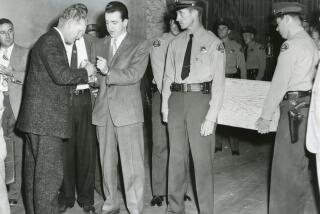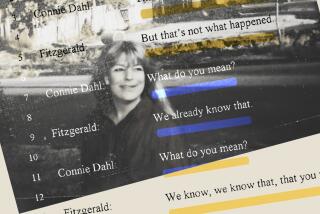Revisiting the Life and Crimes of a Murderer
- Share via
LONDON — During the 36 years she spent in prison, and now in death, Myra Hindley has tormented Britain like no other murderer in memory, her name a shorthand for the monstrous crime of child killing, her bottled-blond 1960s mug shot still a provocation to fury.
It is a spell that endures even as her body awaits cremation in a hospital morgue under police guard. Since Friday, when her tobacco-ravaged lungs apparently gave out at age 60, the British have been revisiting the terrible details of her part in the murders of five children -- and it is stomach-churning reading.
She is so reviled that her funeral will be conducted in secret, probably in the middle of the night, officials say.
But there is also a nagging uncertainty among some that Hindley was punished beyond what justice demanded. A small but devoted circle of Hindley supporters argues that she was a victim of mob punishment, left to die in prison because of a peculiarity of British law that allows the government to keep some criminals locked up at its discretion.
The special measure was introduced in the mid-1960s at the time that Britain outlawed the death penalty. It gives the home secretary the power to indefinitely extend the sentences of prisoners whose terms are designated “whole life” -- a form of assurance to those who worried that the most heinous killers would do their prison time and then return to the streets.
Hindley was one of 23 people serving a whole life sentence, despite the British parole board’s having assessed her as a low-risk prisoner five years ago, suggesting she be moved to a low-security facility. She remained locked up, the law’s critics say, only because no politician would risk the popular backlash that would inevitably follow her release.
For evidence, the critics point to Hindley’s treatment at the hands of Britain’s tabloid press. The papers never forgave her for the murders, shouting down every legal attempt she made to win release. To the tabs, she was beyond redemption. “The Final Injustice: She Died Peacefully,” was the Daily Mail’s verdict this weekend on Hindley’s passing.
“The tabloids ratcheted up the hatred for Myra to such a point that it was impossible for any politician to give up the power to keep this icon-ess of evil behind bars,” said Geoffrey Robertson, a London human rights lawyer who represented Hindley in one parole application. “Perhaps her death will provide the opportunity for politicians to realize they no longer need this antiquated power.”
Indeed, the House of Lords is expected to rule within months on whether the power of a politician to overrule the judiciary on sentencing is compatible with Britain’s new Human Rights Act and its legal commitments to European human rights conventions. If the House of Lords does strike down the law, some observers noted, Hindley may have been on the threshold of freedom when she died.
Yet Hindley occupied a morally bewildering terrain, and ascertaining her appropriate punishment has always been fuel for argument. Her expressions of remorse were never widely accepted as genuine. They were too great a leap, perhaps, from the evidence of her deeds.
The facts are chilling and undisputed. She and her lover, Ian Brady, killed five children in the mid-1960s, Hindley luring them out of their innocence and delivering them into his murderous, sexually abusive hands.
The pair took photographs of the gagged and nearly naked children. Perhaps most damning to their defense, they tape-recorded the desperate pleas of one of the victims -- 10-year-old Lesley Ann Downey -- to be set free. Hindley’s unforgettable response to the child’s begging: “Shut up or I will forget myself and hit you one.” They killed with nonchalance.
The two were caught only when they brazenly murdered their last victim, 17-year-old Edward Evans, while Hindley’s brother-in-law watched. He turned them in the next day.
Neither killer showed much remorse during their 1966 trial, although Hindley acknowledged that her failure to come to Downey’s aide was “indefensible” and “cruel.” Both were sentenced to life in prison.
But it was Hindley alone who campaigned for an early release. Brady lost a bid for the right to die, complaining in an open letter in 1999 after Hindley suffered an aneurysm that “Myra gets the potentially fatal brain condition whilst I have to fight simply to die.”
Hindley’s first approach was to portray herself as a victim too, coerced by Brady’s spell over her. And to many of her defenders, she presented a compelling case: a Roman Catholic girl raised in a poor, violent home, desperate for love, who had the misfortune to become besotted with Brady, who tortured cats as a child and would eventually move on to human prey. She said she had been manipulated by her boyfriend, who kept her in line through beatings and rape.
In prison, Hindley eventually rediscovered her Catholic faith and helped police find one of the bodies that the killers had buried on a desolate moor in northern England.
Along the way, she picked up high-profile campaigners for her release, including the late Lord Longford, Britain’s leading prison reformer, who argued that she was truly haunted by her crimes.
But most observers dismissed her 1994 claim to “have paid my debt to society” as nothing more than an outrageous and cynical bid for freedom.
In fact, in 1974, she tried and failed to escape, and it was not until 1987 that she and Brady admitted to two of the five murders.
“The rhythm is all me, me, me, poor me, bright me, persecuted me,” journalist Yvonne Roberts wrote in the Observer newspaper Sunday, describing a one-hour prison conversation she had with Hindley 14 years ago. Roberts asked Hindley how she could take a 10-year-old from a fairground and bring her to Brady to be tortured and raped.
“The girl shouldn’t have been out at that time of night,” Roberts said Hindley replied.
More to Read
Sign up for Essential California
The most important California stories and recommendations in your inbox every morning.
You may occasionally receive promotional content from the Los Angeles Times.













